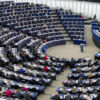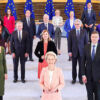Il-ġimgħa l-oħra, bla wisq fanfarri fil-midja, ukoll f’Malta, mill-Parlament Ewropew għaddiet riżoluzzjoni li tippromovi l-kontrolli fuq it-traffiku ta’ minerali rari minn żoni fl-Afrika fejn hemm konflitti u gwerer.
Għax huma mfittxija għal proċessi industrijali sensittivi, il-prezz tagħhom hu għoli ħafna. Il-kuntrabandu fihom qed iservi biex jiffinanzja gruppi armati speċjalizzati fil-qtil u fir-rapiment. Il-ħsieb hu li jitwaqqaf l-użu ta’ minerali li jaslu fl-Ewropa minn dan il-kuntrabandu biex b’hekk il-gruppi armati jitilfu sors ta’ fondi għall-manteniment tagħhom.
Kien hemm min qies li kontrolli ġodda fuq it-traffiku fil-minerali rari jistgħu jwasslu għal skarsezzi u żidiet fil-prezzijiet tal-produzzjoni ta’ materjali importanti fl-oqsma tad-difiża u tal-komunikazzjoni tal-punent. Biss, il-gwerer u t-taqlib vjolenti fl-Afrika qed joħolqu problemi tassew kbar, fosthom bil-mewġ ta’ immigrazzjoni irregolari.
Ir-riskju ta’ skarsezzi u ta’ żieda fl-ispiża tal-produzzjoni kien wieħed li għandu jittieħed.
***
Proġetti kbar
Minn kemm ili nsegwi b’mod jew ieħor il-politika Maltija, dejjem niftakar jissemmew proġetti kbar tal-gvern u tal-privat, li dwarhom saru ħafna wegħdiet u nqalgħu kontroversji liema bħalhom. Uħud twasslu sal-aħħar; oħrajn le.
Fis-snin sittin: Bieb il-Belt; il-proġett tal-karozzi Rambler; l-iżvilupp tal-Wied ta’ Santa Marija; il-bini ta’ Università ġdida f’Tal-Qroqq.
Fis-snin sebgħin: ir-runway għall-jumbo jets; il-ħolqien ta’ tarzna għall-bini tal-vapuri; l-Air Malta.
Fis-snin tmenin: il-bini ta’ port għat-trasbord f’Marsaxlokk u wara fl-istess inħawi, ta’ power station.
Fis-snin disgħin u d-deċenju ta’ wara: proġetti ta’ villaġġi lussużi f’Chambrai, Għawdex, f’Portotmaso u f’Tignè; il-bini ta’ bankini għall-cruise liners; sptar ġdid f’Tal-Qroqq; Bieb il-Belt; Smart City.
Wieħed kien jistenna li matul is-snin, minn dawn l-esperjenzi, sawwarna bħala soċjetà, metodu ta’ kif nikkunsidraw proġetti kbar u kif nittrattaw dwarhom b’mod raġonevoli u oġġettiv.
Ma jidhirx li dan hu l-każ.
***
Kif tagħti merħba
Fl-Asja wkoll reġgħet qamet il-problema tal-immigranti li b’sogru kbir ta’ ħajjithom, jitilqu bid-dgħajjes lejn artijiet oħra.
Din id-darba ma kinux Indoneżjani li telqu lejn l-Awstralja, imma Birmaniżi Musulmani li ħarbu lejn l-Indoneżja. U sa fejn nista’ nifhem, ir-reazzjoni tal-Indoneżja għal dak li kien qed jiġri ftit kienet differenti minn tal-Awstraljani meta resqu l-immigranti lejn pajjiżhom.
It-tnejn ma xtaqux idaħħluhom u raw kif jagħmlu biex jeħilsu minnhom, minkejja l-problemi umanitarji li nqalgħu.
Mhix ħaġa faċli li poplu jaċċetta u jilqa’ fi ħdanu kotra minn poplu ieħor. Qatt ma kienet faċli.
F’sekli oħra, ċaqliq hekk kien isir permezz ta’ invażjonjiet li jekk jirnexxu, ġeneralment kienu jispiċċaw fil-ġenoċidju tal-poplu mirbuħ. Kif ġara bl-“Indjani” tal-Amerika u bl-aboriġeni tal-Awstralja.
English Version – African Minerals
Last week, with minimal coverage in the media, including Malta’s, the European Parliament passed a resolution which advocates controls on the traffic in rare minerals exported from zones in Africa where conflicts and war prevail.
Such minerals are used in sensitive industrial processes and can be very expensive. Contraband in them is helping to finance armed militias specializing in murder and rapine. The intention is to halt the importation into Europe of minerals procured via contraband channels and so deprive militias of the funds that serve to finance their operations.
Some observers claimed that new controls on trade in minerals could trigger a scarcity of supplies as well as increases in the production price of materials that are vital to the defence and communications industries of the West. However, the wars and violent upheavals in Africa are provoking huge problems, among which a surge in irregular migration.
The risks of provoking scarcities and a rise in production costs are well worth taking.
***
Mega projects
For as long as one way or another, I’ve been following Maltese politics, mega public or private projects often featured in discussions. About them many promises would be made and they would give rise to spectacular controversies. Some projects were implemented, others not. Here are some.
During the sixties of the previous century: the Valletta entrance; the Rambler project to assemble cars; the development of Santa Maria valley in Mellieħa; the construction of a new University at Tal-Qroqq.
In the seventies: a runway for jumbo jets; the setting up of a shipbuilding yard; Air Malta.
During the eighties: the construction of a transhipment port at Marsaxlokk, and later of a power station in the same area.
In the nineties and the following decade: projects to build luxury ”villages” at Chambrai, Gozo, at Portomaso and at Tigne; a terminal for cruise liners; a new hospital at Tal-Qroqq; again, the entrance to Valletta; Smart City.
One would have expected that on the basis of these experiences our society would have developed a method by which to consider and evaluate mega projects in a rational and objective manner.
This does not seem to be the case.
***
Welcoming ways
In Asia too the problem of immigration has again become acute – risking their lives, boat people have been leaving their homes for other lands.
This time it wasn’t Indonesians journeying to Australia but Islamic Burmese fleeing to Indonesia. And as far as I can gather, Indonesians reacted to this development in a way that was hardly different from how the Australians had dealt with the immigrants approaching their shores.
Both preferred not to let the immigrants come in and did their best to shove them back, despite the humanitarian crisis this would cause.
No population finds it easy to accept and welcome the arrival in its midst of a crowd of foreigners. It never was easy.
In past centuries, such movement of populations would happen as the result of an invasion which would generally then conclude with the genocide of the losers. That’s what happened to the American ”Red” Indians and to the aborigines in Australia.









Post a comment